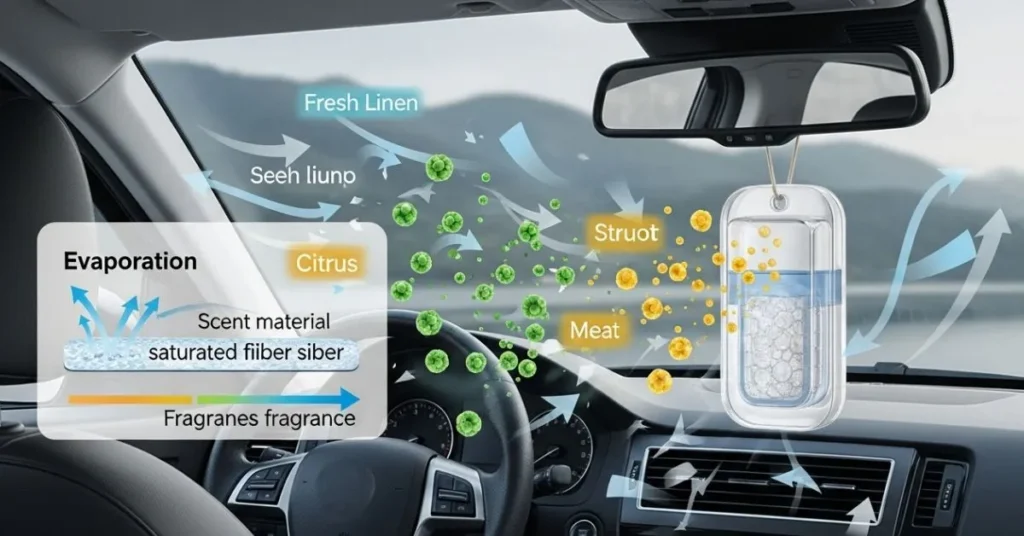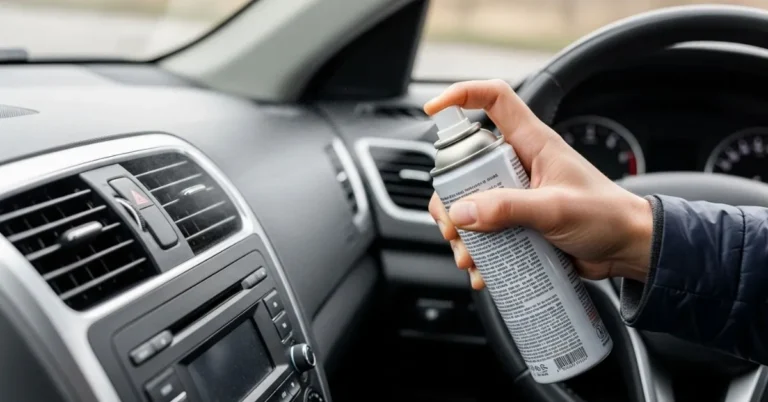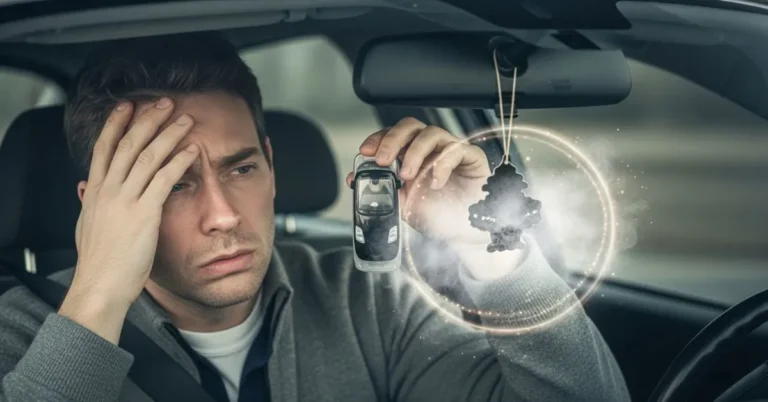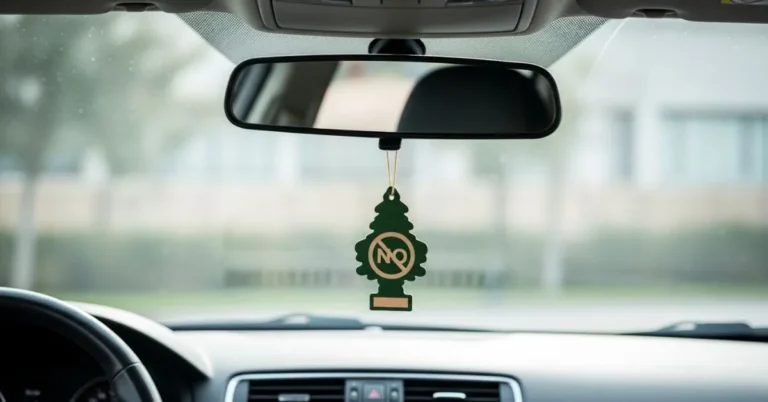
How do car air fresheners work when up against a Monday morning disaster of epic proportions? Imagine this: it was hot, humid, and far too early. I climbed into my car, and before I could even buckle up, the smell hit me like a rogue gym sock straight outta hell. A chaotic blend of old coffee, dog hair, and what I can only describe as expired takeout had created a noxious cocktail inside my trusty Honda Civic.
Panic? Not quite. Despair? Absolutely.
After years of relying on artificial cardboard trees and aerosol sprays that promised “mountain breeze” but delivered full-on chemical warfare, I knew something had to change. I craved a solution that didn’t make my car smell like a synthetic pine forest with a side of cologne.
Enter: essential oils.
But how do they freshen the air? Are they just wellness hype, or can they deodorize your car without the toxic cloud? In this deep dive, we’re breaking down the science, the smells, and the surprisingly soothing benefits of using essential oils to keep your ride smelling like a spa on wheels.
Contents
- 1 1. What Are Car Air Fresheners And Why Do We Need Them?
- 1.1 2. So, Really How Do Car Air Fresheners Work with Essential Oils?
- 1.2 3. Types of Essential Oil Car Fresheners (And Which Ones Actually Work)
- 1.3 4. Why Essential Oils Are Better Than Traditional Fresheners
- 1.4 5. How to Make DIY Car Air Fresheners with Essential Oils
- 1.5 6. Best Essential Oils for Driving: Focus, Calm, or Uplift?
- 1.6 7. How Long Do These Fresheners Last?
- 1.7 8. The Scent Shift: Why More Drivers Are Choosing Oils
- 1.8 9. How to Use Essential Oil Car Fresheners Safely
- 1.9 Frequently Asked Questions
- 1.9.1 1. How do car air fresheners work with essential oils?
- 1.9.2 2. Are essential oil car fresheners safe for children and pets?
- 1.9.3 3. Can I use my home diffuser in the car?
- 1.9.4 4. What’s the most affordable essential oil freshener option?
- 1.9.5 5. How often should I refresh my essential oil car diffuser?
- 1.10 Expert Thoughts: Nature’s Answer to Funky Cars
- 1.11 About the Author
1. What Are Car Air Fresheners And Why Do We Need Them?
Let’s be honest: the interior of a car can be a war zone for odors.
Fast food, coffee spills, wet dogs, teenagers in soccer cleats life happens, and your car becomes the unfortunate nose-level storage unit for it all.
Car air fresheners are designed to tackle these odors through three primary mechanisms:
- Masking: Overpowers bad smells with strong artificial fragrance.
- Neutralizing: Chemically binds to odor molecules to reduce the smell.
- Absorbing: Traps smells using materials like charcoal or baking soda.
Most commercial options rely heavily on synthetic perfumes and chemicals. While they may be effective in the short term, they often cause headaches, allergic reactions, or just plain smell bad.
On the other hand, essential oil car fresheners offer a natural, customizable, and far more pleasant alternative, minus the lab-made aftertaste.
2. So, Really How Do Car Air Fresheners Work with Essential Oils?
Here’s the nerdy (but cool) part.
Essential oil-based car fresheners work via diffusion and evaporation. Simple science with powerful results.
Here’s the process:
- Carrier Material: The oil is absorbed into a material like wood, felt, clay, or lava rock.
- Evaporation: Heat from your car (yes, even that baking-hot dashboard) causes the oil to slowly evaporate.
- Diffusion: As the oil particles evaporate, they’re released into the surrounding air.
- Smell That Goodness: You inhale those aromatic molecules and boom! instant mood lift.
These fresheners don’t just cover up smells they replace them naturally, allowing you to avoid toxic chemicals while enjoying long-lasting scent benefits.
3. Types of Essential Oil Car Fresheners (And Which Ones Actually Work)
There’s no one-size-fits-all, which is excellent news for picky noses like mine. Here are the most popular types of essential oil car fresheners:
Vent Clip Diffusers
- How it works: Clips to your air vents. Airflow helps distribute the scent.
- Pros: Fast diffusion, easy to refresh.
- Best for: Drivers who want a consistent scent while driving.
Wooden Diffusers
- How it works: Porous wood absorbs and slowly releases oil.
- Pros: Eco-friendly, aesthetic, reusable.
- Best for: Minimalist car interiors, slow, steady release.
Felt Pad or Cloth Fresheners
- How it works: Add oil to felt inside a jar or pouch.
- Pros: Cheap DIY option.
- Best for: Glovebox or hanging from your rearview mirror.
Lava Rock Diffusers
- How it works: Absorbs and releases scent over time.
- Pros: Long-lasting, earthy look.
- Best for: Subtle, gradual diffusion.
USB-Powered Diffusers
- How it works: Uses a fan or gentle heat to release scent.
- Pros: High-tech, customizable timing.
- Best for: Rideshare drivers or frequent commuters.
Whatever style you pick, the core concept remains the same: essential oil + heat = wonderful-smelling car.
Read More: How to Make Car Air Freshener Diffuser with Essential Oils
4. Why Essential Oils Are Better Than Traditional Fresheners
We’re not here to drag the classic Little Tree, but if we’re being honest, it had its time. Essential oils, however, are here to stay.
Benefits of Essential Oil Fresheners:
- All-Natural: No harsh chemicals or artificial scents.
- Customizable: Mix your blend based on mood or time of day.
- Affordable: A single bottle can freshen your car for months.
- Sustainable: Reusable materials reduce waste.
- Safer for Kids & Pets: No phthalates, no headaches.
Why settle for “New Car Smell” when you could have real lavender fields?
5. How to Make DIY Car Air Fresheners with Essential Oils
You don’t have to buy anything fancy. Most of these can be made in five minutes with stuff you already have at home.
Mason Jar Air Freshener
- Fill a small mason jar halfway with baking soda.
- Use 10–15 drops of your go-to essential oil to refresh the scent and keep things smelling amazing.
- Cover with breathable fabric or poke holes in the lid.
Wooden Bead Diffuser
- String together raw, untreated wooden beads.
- Add 5–10 drops of essential oil.
- Hang from your rearview mirror.
Felt Pouch
- Cut felt into a small pouch or disk.
- Add oil and place in a small tin or cloth bag.
- Refresh every few days.
Lava Rock Diffuser
- Add oil to a handful of lava rocks in a cloth pouch or tin.
- Place it in your cup holder or glove box.
DIY doesn’t just save money it saves your nose, too.
6. Best Essential Oils for Driving: Focus, Calm, or Uplift?
Your scent should depend on how you want to feel while driving. Here are some top picks and why they work:
For Alertness
- Peppermint: Boosts focus and energy.
- Rosemary: Improves memory and mental clarity.
To Relieve Stress
- Lavender: Calming, ideal for traffic jams.
- Chamomile: Reduces anxiety and road rage.
For Mood Boost
- Sweet Orange: Bright and cheerful.
- Lemon: Clean, fresh, and energizing.
Oils to Use Cautiously
- Cinnamon, Clove: Too intense for small spaces.
- Tea Tree: Strong medicinal scent not for everyone.
7. How Long Do These Fresheners Last?
Fresheners using essential oils typically last 1 to 4 weeks, depending on:
- Material: Lava rock and wood absorb more and last longer.
- Oil Quality: Pure essential oils last longer than diluted blends.
- Car Temperature: Heat speeds up evaporation.
- Exposure: Vents push scent out faster, but use oil quicker.
Pro tip: Refresh the oil instead of tossing the whole thing. It’s wallet and earth-friendly.
8. The Scent Shift: Why More Drivers Are Choosing Oils
Here’s what’s trending among car owners:
- Sustainability: Reusable diffusers and plastic-free packaging are available.
- Health Consciousness: No more breathing in mystery chemicals.
- Custom Scent Blends: People love personalizing their ride’s vibe.
- Aesthetic Appeal: Wooden diffusers are as pretty as they are practical.
Bonus? Essential oils smell authentic like nature intended not like a knock-off cologne sample.
9. How to Use Essential Oil Car Fresheners Safely
We’re talking about concentrated oils here, so a little goes a long way.
Do:
- Test a few drops first.
- Keep away from direct sunlight when not in use.
- Store oils safely, especially around pets and kids.
Don’t:
- Oversaturate your diffuser.
- Use oils that make you sleepy (hello, lavender) on long drives.
- Let oil touch plastic surfaces it can damage them.
Read More: How to Put an Air Freshener in Car Like a Pro: Easy DIY Tips
Frequently Asked Questions
1. How do car air fresheners work with essential oils?
They use felt, wood, or stone to absorb the oils and slowly release the scent through evaporation and air diffusion.
2. Are essential oil car fresheners safe for children and pets?
Yes, when using pet/kid-safe oils like lavender or sweet orange in moderation, avoid spicy or heavily concentrated oils.
3. Can I use my home diffuser in the car?
If it’s a USB-powered or spill-proof model made for travel, avoid water-based diffusers that can leak.
4. What’s the most affordable essential oil freshener option?
DIY felt or mason jar fresheners cost pennies and last weeks super budget-friendly and effective.
5. How often should I refresh my essential oil car diffuser?
Refresh every 1 to 2 weeks, depending on the oil and material. Add a few drops once the scent begins to wear off.
Expert Thoughts: Nature’s Answer to Funky Cars
Let’s wrap it up, shall we?
How do car air fresheners work with essential oils? Through the beautiful combination of diffusion and evaporation, these fresheners release pure, natural scent molecules into the air, leaving your car smelling amazing without the headache-inducing chemicals.
They’re affordable, safe, eco-conscious, and a massive upgrade from whatever scent “Wild Ice Storm” is supposed to be.
If you’re ready to say goodbye to synthetic scents and hello to a smoother, fresher ride, essential oils are your new best friend. And your passengers? They’ll thank you.




